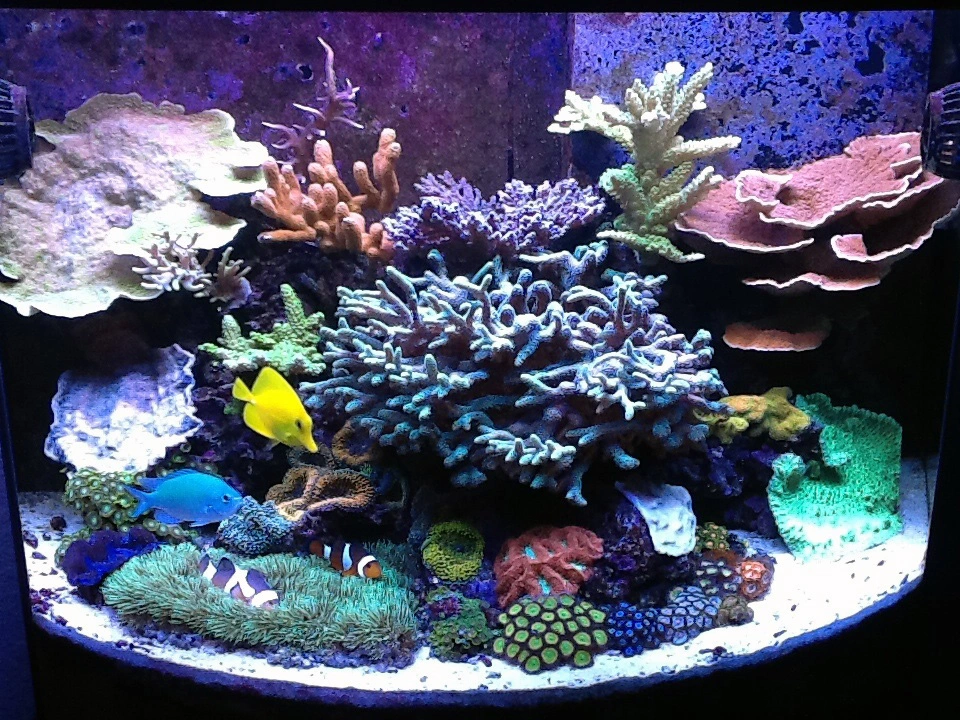Stunning 26-Gallon Reef Tank – Chadf's TOTM | NanoReef

Tank Specifications
Volume: 26 Gallons / 98 Liters
Dimensions (L × W × H):
24.0" ×
15.0" ×
21.0"
61.0cm ×
38.1cm ×
53.3cm
Equipment List
- Salt: Instant Ocean
Frequently Asked Questions
What is the recommended lighting setup for a nano reef aquarium?
For a nano reef aquarium, using T5 lighting is highly recommended. In this case, Chadf uses a 4 x 24w Coralife Lunar Aqualight T5 fixture with ATI and KZ bulbs, supplemented by two Ecoxotic Stunner LED strips. This combination provides excellent light coverage and helps corals achieve vibrant colors.
How do I maintain water quality in my reef tank?
To maintain water quality, Chadf performs a 15% weekly water change using distilled water and Instant Ocean Reef Crystals salt mix. Additionally, he tops off water manually every day to combat evaporation.
What is the ideal routine for feeding the fish in a reef aquarium?
Chadf feeds his fish daily. It's important to monitor how much food is given to prevent overfeeding, which can lead to poor water quality.
How often should I test the water parameters of my reef tank?
Testing should be done regularly. Chadf tests specific gravity weekly with a calibrated refractometer and checks magnesium, calcium, and alkalinity once a month using Salifert test kits.
What is the importance of a protein skimmer and how often should it be cleaned?
A protein skimmer is crucial for removing organic waste and maintaining water quality. Chadf uses an AquaC Remora skimmer, which should be cleaned regularly to ensure efficient operation.
What specific types of corals are suitable for a nano reef tank?
In Chadf's 26-gallon nano reef, he successfully keeps various types of corals, including SPS (Small Polyp Stony) corals like Montipora and Acropora, LPS (Large Polyp Stony) corals such as Blastomussa, and soft corals like Palythoas and Ricordea. It's essential to consider light and flow conditions for each species.
How do I promote coral growth and color?
Chadf doses 2 capfuls of Seachem Reef Fusion Part 1 and 3 capfuls of Part 2 every night to provide essential trace elements for coral health. Maintaining the right lighting and parameters, including calcium and alkalinity, also plays a significant role in promoting growth and color.
What are the benefits of using a digital controller in a reef tank?
A digital controller, like the Digital Aquatics Reefkeeper Lite used by Chadf, provides peace of mind by monitoring and automating various functions in the tank, such as heaters. This helps prevent catastrophic issues such as overheating.
What circulation equipment is recommended for a nano reef aquarium?
Chadf uses two Vortech MP10s set at 75% reef crest mode for optimal water circulation. This setup prevents detritus buildup and ensures that corals receive adequate flow without being stressed.
What should I do if I notice algae growth in my aquarium?
If you notice algae growth, it's essential to first identify the cause, which could be excess nutrients or inadequate water flow. Regular maintenance such as cleaning the tank, increasing water changes, and ensuring a proper balance of livestock can help manage algae.
How can I control nitrate and phosphate levels in my reef tank?
Chadf mentions he has been able to maintain undetectable nitrate and phosphate levels through a well-established deep sand bed and effective protein skimming without the need for chemical filtration. Ensuring proper feeding and regular maintenance also helps in controlling these nutrients.